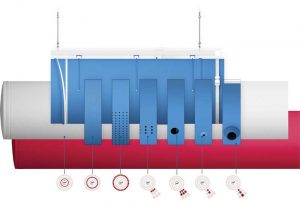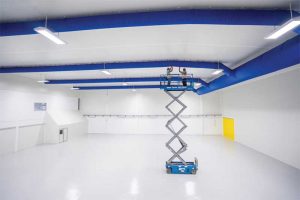Fabric duct also decreased labor costs for the 8361-m2 (90,000-sf) facility and reduced trade stacking, because it installs up to 60-percent faster than metal duct. The expedited installation cut six to eight weeks from the ductwork installation time, says Myers. Further, the fast-tracking allowed other trades to complete their work sooner than if conventional metal ductwork had been used. The fabric duct’s single-point aluminum suspension system serving the Olympic-sized competition pool and six-lane diving well was installed in just 10 days. Afterward, only five days were needed to hang the 299-m (980-ft) of fabric ductwork, consisting of 2438-mm (96-in.) diameter headers and branches ranging from 1219- to 1422-mm (48- to 56-in.) in diameter.
Energy efficiency
Studies have shown fabric duct uses less energy than metal because its air dispersion methodology provides uniform distribution throughout a space with fewer dead or static spots. As a result, the designer can achieve a consistent temperature, and the mechanical equipment runs less.
One study, “Thermal Comparison Between Ceiling Diffusers and Fabric Ductwork Diffusers for Green Buildings,” compared the heating performance of metal versus fabric duct at various flow rates. Conducted by the Department of Mechanical Engineering at Iowa State University, in Ames, Iowa, the study showed that fabric duct heats rooms faster, more uniformly and, as a result, more efficiently. The fabric system was 24.5 percent more efficient than the ceiling metal diffuser system. The latter fell short because a significant fraction of distributed air stayed along the ceiling. The fabric system’s higher velocities and multiple outlets resulted in more energy absorption by the room. Systems reach set points more quickly which decreases the mechanical system’s runtime.
Fabric can also provide an unlimited number of linear air dispersion vents ranging anywhere from micro-perforations to orifices of several inches in diameter. Unlike spiral metal duct, with registers every 1.5 to 3 m (5 to 10 ft), distributing large volumes of air and requiring reducers, fabric duct’s linear vents distribute air along the entire length.
Consequently, fabric duct also has less friction loss than metal due to fewer reducers. This also creates a more uniform static pressure without requiring reducers.
In addition to linear vents, engineers may often design fabric duct with precise surface permeability via a standalone distribution method or in combination with any vent combinations. This also promotes more uniform airflow, temperatures, and efficiency.

Fabric aesthetics
While fabric duct can be more aesthetic than the external ribbing and protruding registers common with spiral metal duct, it can sag and deflate when the air handler is off or operating at partial capacity. As a result, the fabric duct industry has taken great strides to reverse this disadvantage by using internal and external support systems which give it a near or 100-percent inflated appearance.
Shape retention innovations include metal or fiberglass internal or external support hoops. Depending on the manufacturer, these supports are factory installed and do not require assembly onsite; however, there are some types that may require additional labor. Visible external hoops affect the streamlining of the duct surface, but do not add friction loss. While internal hoops are not visible from the outside, they can add significant friction loss, if left exposed inside the duct. However, if the internal hoops are enclosed in fabric sleeves, there will be a significant decrease in friction loss.

Another aesthetic advantage of fabric systems is the diversity of colors and patterns that are available. One must paint exposed metal duct, typically in the field, when colors are important to the interior design. For instance, owners regularly specify corporate and school colors, logos, and even patterns on fabric duct systems. Architects can select essentially any repetitive pattern, such as coffee beans for a coffee shop, fruits and vegetables for a grocery store, or camouflage for an outfitter store to supplement or enhance the interior design theme. These same patterns and logos may be cost-prohibitive for metal duct.
Fabric duct serves the education and recreation facility market, specifically gymnasiums and other athletic spaces which are well suited to fabric duct. Activities in gymnasiums typically take a toll on metal duct. Dents and condensation typically perpetuate a long span of corrosion, ending metal duct’s lifecycle prematurely. Further, metal duct coatings are not always reliable. Fabric duct does not require special coatings to protect against corrosion or rust.
For example, Park Hill Baptist Church in North Little Rock, Arkansas, needed to replace its Christian Activities Center’s (CAC’s) gray coated 660-mm (26-in.) diameter metal HVAC duct after several unsuccessful recoating attempts. The double-wall spiral duct had become a dented, dirty, flaking eyesore for the 1500-member church.
Replacement with metal duct was estimated at $100,000 for demolition and installation labor/materials, not to mention a lengthy weeks-long downtime.

Instead, the church installed 711-mm (28-in.) diameter black fabric duct which the fabricator custom manufactured and shipped directly to the jobsite. Once the contractor anchored the system’s suspension system, installation required only a few hours of sliding the fabric duct clips into the suspension system and zippering lengths together. In total, the fabric duct cost the church less than $10,000 for materials and significantly less for the fabric duct installation using in-house staff.
Conclusion
Everyone in construction and the HVAC business is feeling the consequences of the global price rise of raw materials. It is unsurprising to see providers of conventional solutions adapt by raising their prices. Unfortunately, contractors, engineers, and others in the construction chain ecosystem are taking the hardest financial hit. Now is a great time to consider a high-quality fabric-based alternative to metal duct.
The pandemic has been a devastating event; however, there might be a silver lining to this dark cloud. The effects of COVID-19 might prompt the construction industry to look elsewhere for suitable, alternative building materials, which will also benefit building owners now and in the future.
Author
 Brian Refsgaard is president of FabricAir in Suwanee, Georgia, a manufacturer of fabric air dispersion duct for almost 50 years. Refsgaard joined FabricAir’s sales staff in 1990 and became the firm’s CEO in 1999. Today, the FabricAir Group operates 13 sales companies globally and offers a full line of fabric duct and accessories. Refsgaard can be reached at br@fabricair.com.
Brian Refsgaard is president of FabricAir in Suwanee, Georgia, a manufacturer of fabric air dispersion duct for almost 50 years. Refsgaard joined FabricAir’s sales staff in 1990 and became the firm’s CEO in 1999. Today, the FabricAir Group operates 13 sales companies globally and offers a full line of fabric duct and accessories. Refsgaard can be reached at br@fabricair.com.




